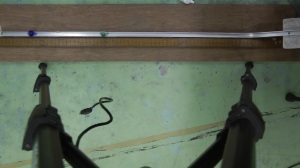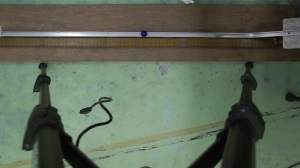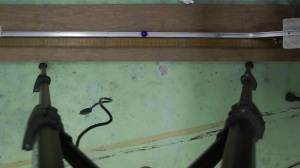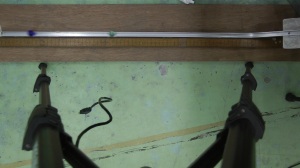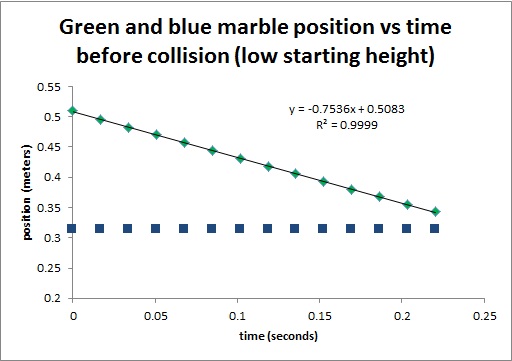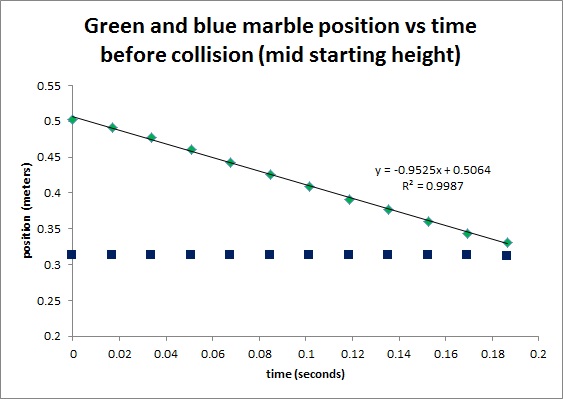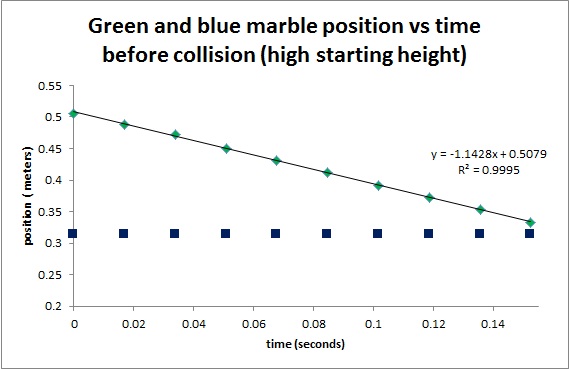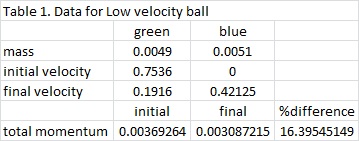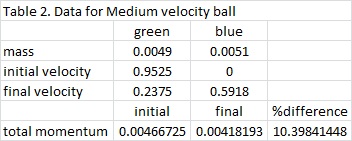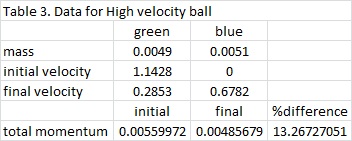If you expect that we are processing some sort of moving objects, that where you are partially wrong. Video processing is just like image processing but with the time factor added. A video is captured by a camera by taking many pictures at a certain rate (e.g. 30 frames/sec, 60 frames/sec). The higher the frame rate is, the finer is the movement of the pictures.
For this activity, we will be using a camera with a frame rate of 59 frames/sec. We will be verifying the Law of Conservation of Momentum for the collision of two marbles. The experimental setup is shown in Figure 2.
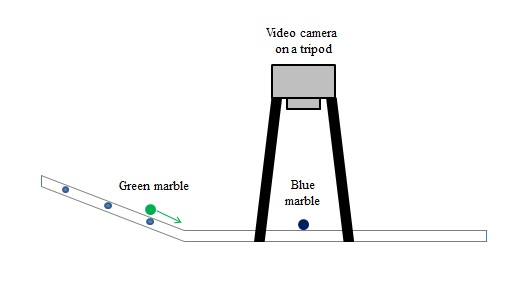
A video camera is setup on a tripod for stability. The camera faces the ramp on to where the blue marble is located. The green marble is initially placed on the slanted side of the ramp to gain velocity. As the green marble enters the straight path, it will travel at a constant velocity. The camera will record the collision of the two marbles. The process is repeated two more times each with a higher velocity (higher velocity is achieved by placing the green marble further up the ramp).
For my approach on the image processing part, firstly, we cropped the image into only the relevant part. We isolated one marble using Parameteric Segmentation. We used a reference color patch of the same color as the desired marble. We then applied Morphological Operations to reshape the segmented marble into a circle. Lastly, we took the mean of the pixel locations of the segmented and morphed shape and recorded it. The whole process is repeated for the other marble.
For the video processing part, we first converted the video into an image file using the program Video to JPG converter. We noted the numbers of the initial frame (first frame where both marbles are inside the cropped frame) and the final frame (last frame where both marbles are still inside the cropped frame) with both marbles still having a circular shape. Figures 4 to 9 shows the images of the initial and final frames. From this, we created a loop in the program to perform the said image processing (from last paragraph) and gather the location data for all frames that are involved. The gathered position data will be plotted versus time. The time part will be an array created using the frame rate. The interval of each frame is 1/59 seconds.
On the plots in Figures 10 to 15, the slope for the flat lines are assumed to be zero, the slopes for the other lines are displayed. The slope of a line is the first derivative of y with respect to x. For this case, the slope of the line is the first derivative of position with respect to time i.e. the velocity of the ball. Using the equation for the Law of Conservation of Momentum,
m1v1i + m2v2i = m1v1f + m2v2f
where m1 is the mass of the blue ball, m2 is the mass of the green ball, v1i and v1f are the initial and final velocities of the blue ball, and v2i and v2f are the initial and final velocities of the green ball. The marbles have a known mass of 0.0051 kg for the blue marble and 0.0049 for the green marble. The list of known values for this experiment is shown in Tables 1 to 3.
It can be observed that when the collision occurs, some of the initial momentum are lost. In Table 1, there is a 16.4% difference in the momentum of the initial as compared to the final. Tables 2 and 3 have 10.4% and 13.3% difference, respectively. But in all cases, the initial is always greater than the final. The equation for the Law of Conservation of Momentum only holds for ideal states. It means that it is only true for systems without friction, and no other outside forces to disturb the system. For this case, it obvious that the ramp has friction on the marbles that is why a decrease in momentum occurs. It is also observed during the experiment that when collision happens, marble jumping occurs. The marble jumped upward before following its intended path. In this jumping, momentum loss may have occurred. But nonetheless, momentum is still preserved and the Law of Conservation of Momentum still holds true.
Review:
First of all, I would like to thank my partner in this activity, Ralph Aguinaldo, for helping me finish this activity and for the analysis part. I would also like to thank Dr. Soriano for her continued support over us in our endeavors to finish this activity.
For this activity, I would give myself a 12 for doing all necessary work and for understanding every bit of it. It is not easy to do this activity when it is very hard to imitate an ideal system. But above all that, we have still done it and got only a small difference of at most 16%.



